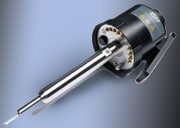Atmospheric Solids Analysis Probe (ASAP)
Rapid direct analysis of volatile and semi-volatile, solid and liquid samples
The Atmospheric Solids Analysis Probe (ASAP) is a useful tool for the rapid direct analysis of volatile and semi-volatile, solid and liquid samples using atmospheric pressure ionization.
The ASAP technique utilizes the heated nitrogen desolvation gas to vaporize the sample and a corona discharge for sample ionization. This allows low polarity compounds not amenable to ESI, APcI and APPI to be ionized with a high degree of sensitivity. Furthermore complex mixtures can be analyzed without the need for any sample preparation.
Overview
Sensitivity and safety by design
The Waters Atmospheric Solids Analysis Probe is readily fitted to a standard API source by replacing either the ESI or APCI probe assembly. A corona discharge pin also requires fitting. The close proximity of the sample, when loaded onto a glass capillary tube, to the point of ionization and the MS inlet, improves sensitivity while also ensuring safety due to the enclosed source housing.
Instruments are operated in combined Electrospray/APcI mode (ESCi). This provides for the acquisition of both analyte data in APcI mode and reference data in electrospray mode, enabling exact mass measurements to be produced.
The probe is designed to have both fixed and removable sections to allow rapid sample introduction without removal of the complete assembly ensuring stable source conditions.
Equipment and installation
The Atmospheric Solids Analysis Probe accessory comprises the probe body with removable sample insertion probe assembly, corona pin, glass sample capillaries, and operator's guide. Additional software (included) is also required for selected instruments.
There are two versions of probe, depending on the design of the instrument's API source assembly.
The probes are user-installable. However engineer installation and operation confirmation and training is available and recommended.
Instrument compatibility
The Atmospheric Solids Analysis Probe is compatible and supported with the following instruments:
- ACQUITY SQD/TQD
- SQ Detector 2/Xevo TQD
- Xevo TQ MS, Xevo TQ-S, Xevo TQ-S micro
- Xevo G2 Tof, Xevo G2-S Tof, Xevo G2-XS Tof
- Xevo G2 QTof, Xevo G2-S QTof, Xevo G2-XS QTof
- (MALDI) SYNAPT G2 MS, (MALDI) SYNAPT G2 HDMS
- (MALDI) SYNAPT G2-S MS, (MALDI) SYNAPT G2-S HDMS
- (MALDI) SYNAPT G2-Si MS, (MALDI) SYNAPT G2-Si HDMS
